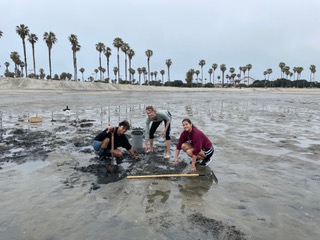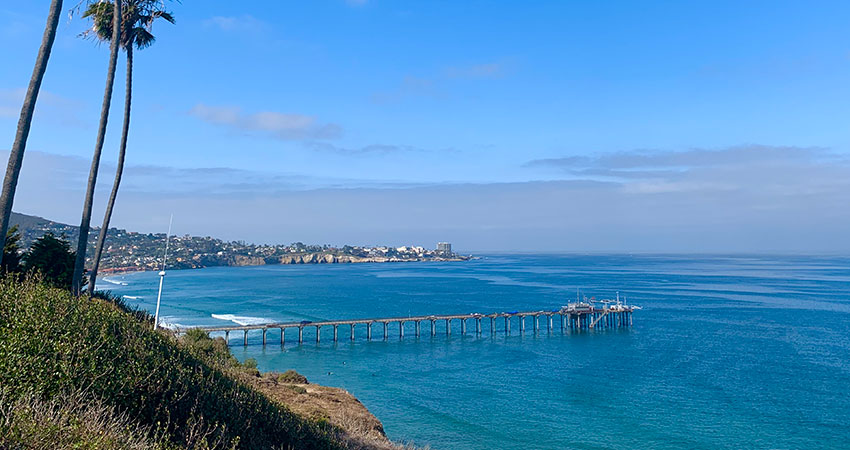West Coast Venus Clams
West Coast Venus Clams
Chione californiensis, Chione undatella
The Science
THE SCIENCE
![Photograph by Joop Trausel and Frans Slieker [4]](/sites/default/files/styles/800px/public/2022-05/thescience.jpg?itok=oMDl2QjU)
Taxonomic description
- Mean (±1SD) length 2.94 ± 0.22 cm; maximum length of around 6.35 cm. [1]
- Thick, oval-shaped shell.[1]
- Color range varies, including white, ivory, gray, pale pink. [4]
- Radiating bands and very closely spaced radial and concentric ridges (C. californiensis and C. undatella, though C. undatella ridges are more closely spaced). [1]
Distribution
- From Point Conception, Santa Barbara County, California (lat. 34°25'N) to Panama. Few findings of Chione all the way down in Peru from limited records. [1]
- Most relatively abundant clam in the intertidal zone in some sites along the Pacific coast of Baja California Sur. [3]
Life history
- Life span of 1-2 years.
- External fertilization; Gametogenic progression in male and female clams is categorized by five stages: inactive, gametogenesis, ripe, spawning and spent. [3,7]
- Embryos develop into free-swimming trocophore larvae, succeeded by the bivalve veliger resembling a miniature clam. [5]
- C. californiensis:
- Actively spawns in warmer months (June to September) with a peak in August when temperatures are near 29°C. [3]
- Ideal temperatures for spawning: ~ 22-30 ℃; Spawning is interrupted when temperatures fall below 24°C. [3]
- Gametogenesis is directly related to variations in temperature; the frequency of spawning individuals increases with rising temperature and vice versa. [3]
- C. undatella:
- Size at first maturity is 57mm LC. [6]
- Reproductive throughout the year, with peak spawning in late spring or early summer. [4,16]
- Shell growth increases with summer spawning season. [17]
Habitat
- Gastric content observed to be only phytoplankton. [8]
- C. californiensis:
- Higher abundance in areas with fine/very fine sand, or sand-silts with lower abundance in sediment containing clay. [2]
- Occurs on flats of sloughs, coves and bays, primarily in the intertidal zone (as deep as 50 m) where it is the most common clam at some sites along the Pacific coast of Baja California Sur. [2,3]
- C. undatella:
- Primarily found near mouth of bays, in well-flushed sandy areas, or near and in eelgrass beds. [15]
- Species does not grow below 17 ℃ (62.6 °F) with ideal temperature: ~17-24℃ (62.6 - 75.2°F). [15]
The Fishery
THE FISHERY

Photo: T.S. Talley
Seasonal availability
- Available year-round.
Regulatory and Managing authority
- The California Department of Fish and Wildlife (CDFW) requires clam diggers to have a valid sports fishing license. For wild harvest, there is a size limit of 1.5in shell diameter.[18]
- Aquaculture operations are subject to approval by the California Department of Fish and Wildlife and/or the Fish and Game Commission. Permitting is complex and involves multiple state, federal and local agencies, and varies with species, location, and more.
- The Permit Guide to Aquaculture in California outlines the permitting and registration process.
Gear type
- Besides using hands and feet to dig through the sand, rakes and shovels are also common. [10]
Status of the fishery
- There is no established commercial fishery for Venus clams in California.
- C. undatella is currently cultured on the Gulf of California in Baja California, Mexico.[4]
- With the growing interest in culturing of native species, west coast Venus clams are a promising species for aquaculture given recent research in California[19,20] and success in Baja California. [4]
Potential ecosystem impacts
- Wild harvest requires digging up substrate which can have localized, temporary impacts from the disturbance.
- Operational impacts of aquaculture are considered minimal. Clams subsist on plankton filtered out of the water and therefore require no feed; additionally, effluent water at culture sites is highly regulated. [18]
The Seafood
THE SEAFOOD
![Photo by El Sargazo [14]](/sites/default/files/styles/800px/public/2022-05/almeja-chione1-600x600.png?itok=hj1IYZMp)
Edible portions
- The entire soft-bodied clam is edible. [12]
Description of meat
- Firm and sweet. [11]
Culinary uses
- Most often steamed. [11]
- Can be included in pastas, soups, or rice. [11]
Nutritional information
- No current nutritional information is available for west coast Venus clams, but shown is information for the Pacific littleneck clam. [21]
Toxicity report
- West coast Venus clams, as with many shellfish, have the potential to naturally accumulate algal toxins such as domoic acid and PSP (paralytic shellfish poisoning), which can be a health hazard for human consumption. The California Department of Public Health provides updated shellfish advisories. [13]
- Farmed shellfish undergo depuration (time in clean water to clear any contaminants) and are tested for safety before being sold.
Seasonal availability
- Available year-round. [11]
References
[1] Parker, P. 1949. Fossil and Recent Species of the Pelecypod Genera Chione and Securella from the Pacific Coast. Journal of Paleontology, 23(6), 577-593. Retrieved May 13, 2021, from http://www.jstor.org/stable/1299665
[2] García-Domínguez F, Arvizu-Martínez J, Rodríguez-Astudillo S,Ramírez-Sevilla R. 1994. Distribución y abundancia de Chione californiensis (Pelecypoda: Veneridae) en la Ensenada de La Paz, Baja California Sur, México. Rev. Biol. Trop. 42(3): 531–536.
[3] García-Domínguez F, García-Melgar G, Gonzalez-Ramirez P. 1992. Reproductive Cycle of the Clam Chione Californiensis (Brodeiup, 1835) in Bahia Magdalena, Baja California Sur, Mexico. Ciencias Marinas. (1993),19(1):15-28. https://www.cienciasmarinas.com.mx/index.php/cmarinas/article/view/923/845
[4] Baqueiro, E., M. Castagna. 1988. Fishery And Culture Of Selected Bivalves In Mexico: Past, Present And Future. VIMS Articles. 1287. https://scholarworks.wm.edu/vimsarticles/1287
[5] Ruppert, E.E., R.S. Fox and R.D. Barnes. 2004. Invertebrate Zoology. A functional evolutionary approach. 7th Ed. Brooks/Cole, Thomson Learning learning, Inc. 990
[6] Arce-Peinado, C.A, Arellano-Martínez, M, Ceballos-Vázquez, B.P. 2018. Reproductive cycle of venus clam Chione undatella in the coasts of the Santa Rosalía mining region, Baja California Sur, Mexico. Hidrobiológica [online]. 2018, vol.28, n.3, pp.325-334. Epub 25-Mar-2020. ISSN 0188-8897. https://doi.org/10.24275/uam/izt/dcbs/hidro/2018v28n3/ceballos.
[7] Baqueiro, E. y Stuardo, J. 1977. Observaciones sobre la biología, ecología y explotación de Megapitaria aurantiaca (Sow., 1835), M. squalida (Sow., 1835) y Dosinia ponderosa (Gray, 1838) (Bi- valvia: Veneridae) de la Bahía de Zihuatanejo e Isla Ixtapa, Gro., México. An. Centro Cienc. del Mar y Limnol. UNAM, 4(l): 161-208.
[8] Garcia-Dominguez, F., Felix-Pico, E. F., Juarez-Olvera, C. D., & Ibarra, N. R. 1996. Feeding of Chione gnidia (Broderip & Sowerby, 1829), C. undatella (Sowerby, 1835) and C. californiensis (Broderip, 1835) (Veneridae) at Ensenada de La Paz, Baja California Sur, Mexico. Retrieved from https://www.infona.pl//resource/bwmeta1.element.elsevier-e66e154d-ee28-31a5-89eb-7a7fef866e17
[9] Chione californiensis (Broderip, 1835). (n.d.). Retrieved from https://www.sealifebase.se/summary/Chione-californiensis.html
[10] Evans, M. 2018. Fishing for Live Clams on Los Angeles Beaches. USA Today. https://traveltips.usatoday.com/fishing-live-clams-los-angeles-beaches-110443.html
[11] El Sargazo. (n.d.). Almeja Chione – Sargazo. Sargazo. https://sargazo.com/producto/almeja-chione/
[12] Peterson, E., & Ambrosino, G. 2018. Clams 101: A How-To Guide | Edible Jersey. Edible Jersey. https://ediblejersey.ediblecommunities.com/eat/clams-101-how-guide
[13] California Department of Fish and Wildlife. 2021. Health Advisories and Closures for California Finfish, Shellfish and Crustaceans. California Department of Fish and Wildlife. https://wildlife.ca.gov/Fishing/Ocean/Health-Advisories
[14] Eagletusk. 2018. Oregon Coast Clamming. Wikimedia Commons. https://commons.wikimedia.org/wiki/File:Oregon_Coast_Clamming.jpg
[15] Hatch, B.A.M.. 2012. “The sclerochronology of Donax gouldii and Chione undatella: Environmental archives of the past and present Southern California Bight”. University of California, San Diego. https://escholarship.org/content/qt7vw867wr/qt7vw867wr_noSplash_47ba7a646c4092ac656335e37fbf4cfd.pdf
[16] Cárdenas, E.B., D.A. Aranda. 2000. A review of reproductive patterns of bivalve mollusks from Mexico. Bulletin of Marine Science 66(1), pp.13-27.
[17] Drover, C. 1974. Seasonal Exploitation of Chione Clams on the Southern California Coast. The Journal of California Anthropology, 1(2): 224-232. http://www.jstor.org/stable/27824794
[18] California Department of Fish and Wildlife. 2023. California Ocean Sport Fishing Regulations 2023-2024. California Department of Fish and Wildlife. https://wildlife.ca.gov/Fishing/Ocean/Regulations/Sport-Fishing/Invertebrate-Fishing-Regs
[19] Talley, T. and Culver, C. 2023. Expanding the horizons of west coast aquaculture through culture of native clam species. [Unpublished manuscript].
[20] Wallace, A. 2023. Assessing the effectiveness of integrated multi-trophic aquaculture for growing west coast venus clams. MS Thesis. University of San Diego. https://doi.org/10.22371/02.2023.002
[21] Whole Foods Market. (2022). Littleneck Clams at Whole Foods Market. Whole Foods Market. https://www.wholefoodsmarket.com/product/seafood-littleneck-clams-b079mfzhqt




